Yet another great post! I could not agree more with the “Demonstrate Understanding” versus the simple quiz methods. While both have their place, they should be applied to the right environment!
Again, great article!
– Justin
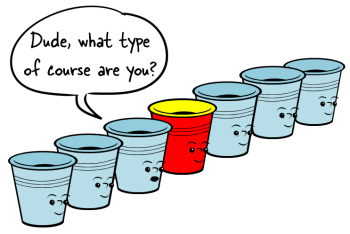
Not all elearning courses are created equal. Some seek to share information and build awareness while others may focus on action or changing behaviors. When building elearning courses, I usually separate them into two buckets: information or performance.
The objective of an information-based course is performance support and not performance activity. Think of it more like multimedia text book. It doesn’t teach and assess performance. Instead it provides the context and awareness of important information. It supports performance but it’s not designed to change performance.
Some people would say that those courses shouldn’t be built. Instead they should be job aids or offline documentation. In some situations that makes sense. But I don’t completely agree with that assertion mostly because building information as a “course” doesn’t take any more effort than building it as a job aid or offline resource. And the other benefit is that it is online and can be purposed in other ways as well.
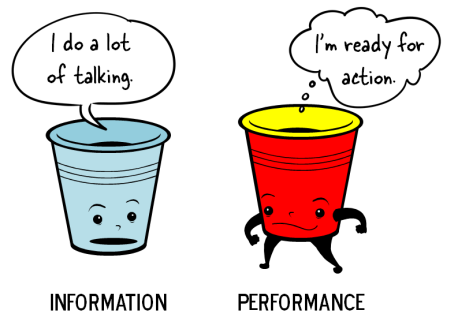
Performance-based courses focus on action. There’s an activity or something that can be done to demonstrate understanding of the online training content. Those courses change behavior. They teach concepts that have real-world application. And they allow the learner to practice and demonstrate the new learning.
Often the two types of courses can be combined. Or as some would suggest, the action oriented courses only focus on the action and any non-critical information is removed from the course and made available via job aids and other channels. Either way works.
Ultimately your success building online training rests in identifying the type of course you’re building, its real objectives, and then allocating the right resources.
There’s a lot of training that is mandated by the organization but has no real performance goal. They’re usually training programs to build awareness around some of the organization’s policies. For example, one organization for which I worked had a strong focus on safety. So each year I had to take courses on lockout/tagout (LOTO) procedures. I didn’t work in a production environment and never had to do any of this in the real world. But the organization wanted everyone to take the training.
In that case, the training for people who didn’t work in a production environment was more about awareness of the organization’s policies and how they impacted the organization’s success. It probably doesn’t make a lot of sense to have them practice if they don’t ever apply it.
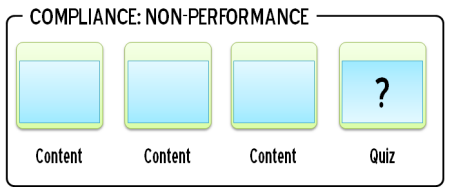
For this type of training the objective is to build awareness. Since the policies are not directly related to the person’s performance, I try to get them in and out of the training as quickly as I can. The goal is not to undermine the organization’s policies. So we want to make sure they get the information they need. But at the same time, we don’t want to lock them up in a course that will take a lot of extra time.
For this learner, I’d build a simple course where they get the information, they’re assessed with a simple quiz or activity, and they’re sent back to productive work.
There’s a lot of compliance training as described above, but there’s also a lot of compliance training that is critical to a job function. For example, assume I work in a production environment and LOTO is critical to my performance. Every year I have to take annual compliance training as a reminder of the LOTO policies and procedures. This is compliance training because I have to comply with the organization’s safety procedures and policies. But this is also performance-based training because the ultimate objective is to understand the policies and be able to demonstrate my understanding in my work environment.
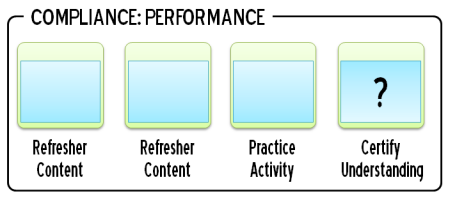
Another assumption is that this type of training is not the initial training. Instead it’s refresher training. So it’s more like a certification process where the learner is reminded of the policies and can DEMONSTRATE the application of it. The training doesn’t teach them something new as much as it certifies what they already know.
Performance-based training focuses on real performance goals. Typically there’s a gap. The learners are at point A and the goal is to get them point B. We determine the cause of the gap; and if training is the appropriate solution we build a course to close the gap.
The ultimate objective for these courses is that the learner is able to DO something after completion. Often our learning objectives will state that “at the end of this course they’ll learn or understand” but that doesn’t mean anything. How do you know they understand? How do you know they learned?
You have to create a way to measure their understanding. There needs to be an action where they can show you what they know.
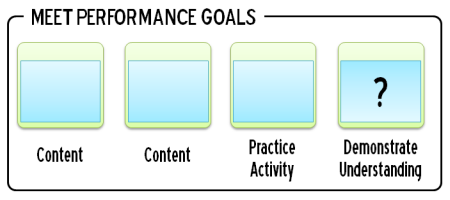
Many elearning courses are structured like this: content, practice activity, assessment. This is OK if the assessment isn’t a quiz (which is limited in how it can measure understanding). If you really want to determine understanding, then craft an assessment that lets them make decisions that are close to the types of decisions they’d make in the real world.
For example, if they need to demonstrate their understanding of LOTO procedures then have them identify where it needs to happen and then go through the process of doing it just like they would in the real world.
If we revisit the three types of elearning courses, we see in one the objective is to build awareness with no performance expectations. But the other two are tied to on-the-job performance. However one is more refresher or certification and the other is more in depth. The two performance course can be combined to create a single course. All you need is a mechanism to filter the learners.
For certification they go one way and for the in-depth training they go another. And during the certification process if they can’t demonstrate the appropriate level of understanding you can redirect them to a remedial path where they can get the information and practice activities they need to fill the gap.
As you can see the objectives of your elearning courses may not be the same. By sorting them the information and performance buckets you’ll be able to determine where to allocate your resources. Annual compliance training with no performance outcomes shouldn’t consume as much of your time and resources as the performance-based courses that will require more interactivity and development.
You’ll save time and money by building the training most appropriate to the objectives. You’ll also help th
e organization by sorting your learners. Those who need a simple course can get in and out and back to productive work; and those that need to demonstrate their understanding will have a course that is more than a simple quiz.
 |
 |
 |
|
Want to learn more? Check out these articles and free resources in the community. |
Here’s a great job board for e-learning, instructional design, and training jobs |
Participate in the weekly e-learning challenges to sharpen your skills |
 |
 |
 |
|
Get your free PowerPoint templates and free graphics & stock images. |
Lots of cool e-learning examples to check out and find inspiration. |
Getting Started? This e-learning 101 series and the free e-books will help. |
Yet another great post! I could not agree more with the “Demonstrate Understanding” versus the simple quiz methods. While both have their place, they should be applied to the right environment!
Again, great article!
– Justin
In a discussion of objectives, I always return to Robert Mager’s points – conditions, action verb, criteria. All objectives including for “information” courses should be stated in terms of what the learner will be able to do as a result of the learning. The conditions and method for the evaluation should be stated and shared with the learner.
How many statements of objectives have you seen lately that clearly specify how the learning will be evaluated?
I am an upcoming graduate student at Roosevelt University who will have a Master’s degree in Human Performance Improvement. I find this information as I begin my career in this field. It is great to know how to create online learning that is beneficial and can get to the point.
I would make the argument that in most cases, buried underneath all that “awareness” information – there are performance objectives.
For example: underneath all that corporate security information is the expectation that employees don’t write their passwords on their desk blotter.
I think part of the problem is that the history of compliance training and the regulatory aspects sometimes are so awful – the designer tends to mail it in… press hard, sign here, three copies.
One of the best training videos I ever saw began with the results of non compliance. It was a real attention grabber and motivated the student to learn more.
Tom, I appreciate your posts every week. Thank you!
Question: To specify learning goals
– do you use/recommend the Bloom (http://en.wikipedia.org/wiki/Bloom's_Taxonomy) taxonomy? Or any other?
– As it is most easy to pick/specify knowledge oriented learning goals it is more difficult to do so _in an elearning environment _with affirmative or even psychomotoric goals. What are those goals you’d pick with elearnings – if any?
– ….any recommendation how to evaluate those goals in a different way as that with cognitive goals?
Excellent post, as always. I would agree with Joe that buried deep under a need for awareness is an objective. Even if the objective is the learner will recite the safety policy. It may seem obvious, but the act of writing that objective down before you start a course clears up any confusion between the stakeholders and the ID.
I enjoyed this article and took some of it on board and related it to education.
Although I may of gone of topic a little….
Hi Tom,
I love your blogs. Very good information. I am also a big fan of allowing learners to demonstrate examples as they would in their current job. Would you say this is more like experimental learning?
Thank you!
Nice post, it will helps who are interesting in online learning. Now a days people like to play online educational quizzes
A great post Tom, as always. For me learning is always related to a change of behavior. A before state A towards a desired stated B. I totally agree that we measure their performance. But I would like to argue, that as instructional designers, should also find creative ways to establish the assimilation of the objectives learned in a later time (i.e, besides the certification process, a process for instance of online meeting, or conference, etc) to establish the degree in which someone actually use the new skills in his/her everyday challenges. Just a thought!!!
Hi,
Thanks for the share.It is great to know the three ways of online training program.
Hi there
I’m confused and would like to hear more about courses where information alone is the main objective in the context of corporate training.
My confusion stems from my thinking (and I’m happy to have it corrected) about what constitutes effective training and effective policies. I’ve always thought that training is a solution to a business problem. Effective policies are proactive ways of heading off business problems or reactions to past problems.
So,if the business problem that training is attempting to solve is “people don’t understand or follow our policies” then the question that I would ask (if it’s not clear from the policy or policies)is “How is ignorance of your policies negatively impacting your business/organisation and how will things be better when your policies ARE understood and followed?”
I get that in formal training there needs to be underpinning knowledge. For instance,in some family counselling qualifications one needs to memorise and understand the hierarchy of the family court system and demonstrate an understand of relevant legislation before attempting client scenarios.
But for corporate training, unless the sole objective is tick and flick/cover our bums (which is not effective training) – is demonstrating knowledge that policies exist really going to be beneficial? Or should trainees be asked to demonstrate their understanding of the behaviour that results from knowing and adhering to those policies?
Deep thoughts for a Sunday afternoon and looking forward to discussion.
Cheers
KerryJ
“As you can see the objectives of your elearning courses may not be the same. By sorting them the information and performance buckets you’ll be able to determine where to allocate your resources.” Great! Couldn’t have put it better.
I’ve deveopled a lot of compliance training over the years, starting with instructor led, but more WBT in the last few years. I agree with both sides of the agrument (to some degree) as to whether the objectives are tied to performance or behavior change. The expectation for compliance training is often to have an employee behave in a certain way. I’ll use an example of WBT training on how to fill out your timesheet. The corporate expectation is fill out the timesheet according to the company policy and to understand the comsequences if ypu don’t. But in order to have them demonstrate that they can do that for all the different situations, i.e. overtime, vacation, amending errors, etc. you’d have to develop an extremely complicated interaction that proves they know how to do it, which is usually more time and money than the customer wants to spend. Instead giving them the information, testing their knowledge of the rules is done in WBT, and coaching/mentoring is used (normally done by the supervisor) when it’s time to actually do the timesheets. Bottom line to me as that sometimes it’s not worth the time and money to link awareness training to peformance. And related to another comment on effective training vs effective policies. It has been my expereince with large corporations, that the people writing the company policies do a very bad job of it because they didn’t get training on how to do that. So instead of writing a better document that can be understood just from reading it training is mandated to correct the mistakes made from not being able to understand the document.
What a great post! I never thought about separating the purposes of an elearning course into either information or performance tasks. I think you did a great job on distinguishing the objectives. I’m currently taking my Master’s Program in Instructional Design and have learned from my resources that I have read that you will save money and time by building the training that correlate with the training objectives. One of the best resources I have read so far is, Designing Effective Instruction by Morrison, Ross, Kalman, and Kemp. They stated,” Appropriate training can produce a return on investment for both tangible and less tangible measures.“ I couldn’t agree more, as a coach and teacher my goal is to make the concepts I teach easy to understand and the goal of instructional design is to make learning more efficient and effective and less difficult. I think that the information you share in your blogs are very helpful. Keep it up!
Hi Tom. I have really enjoyed discovering your blog, and reading some of the insights you have into the world of instructional design. As a graduate student in ID, your blog is a fantastic resource to answer some questions that I am forming as my program rolls along.
One question I do have for you is based on your opinion about compliance training vs performance training. If we know that the brain can be more likely to store information into long term memory with various approaches and exposures to content, why would you “…build a simple course where they get the information, they’re assessed with a simple quiz or activity, and they’re sent back to productive work.”?
As an instruction designer, do you feel the urge to have your learners explore this content to give them ample opportunity to store the information in their long term memory? Or is there a lot of pressure from your employer to just simply comply with the policies, and concentrate your efforts on other trainings?
Thanks so much for all the information you provide.
Excellent information about objectives of training program!! learnt a lot!!
0
comments